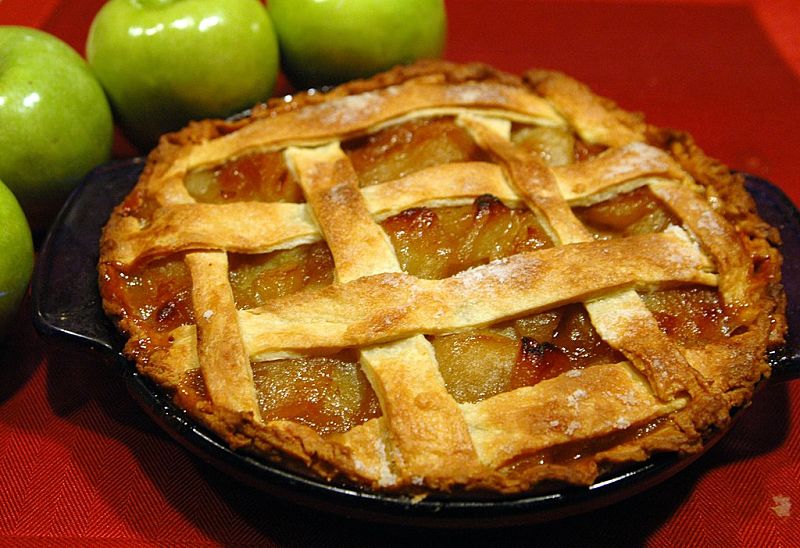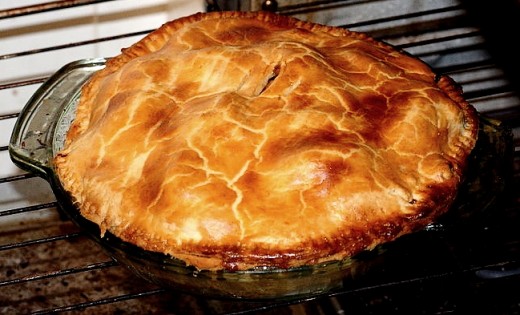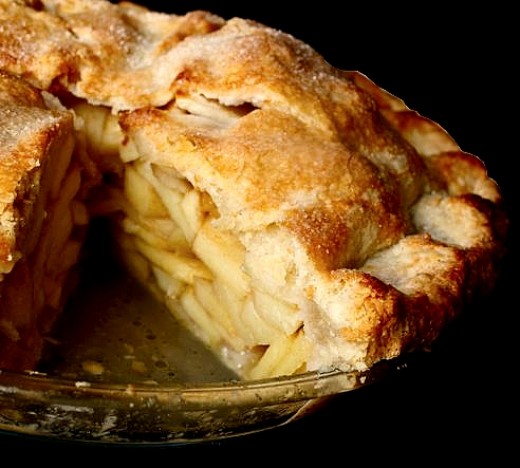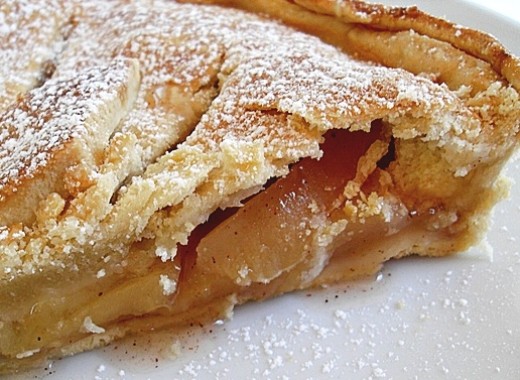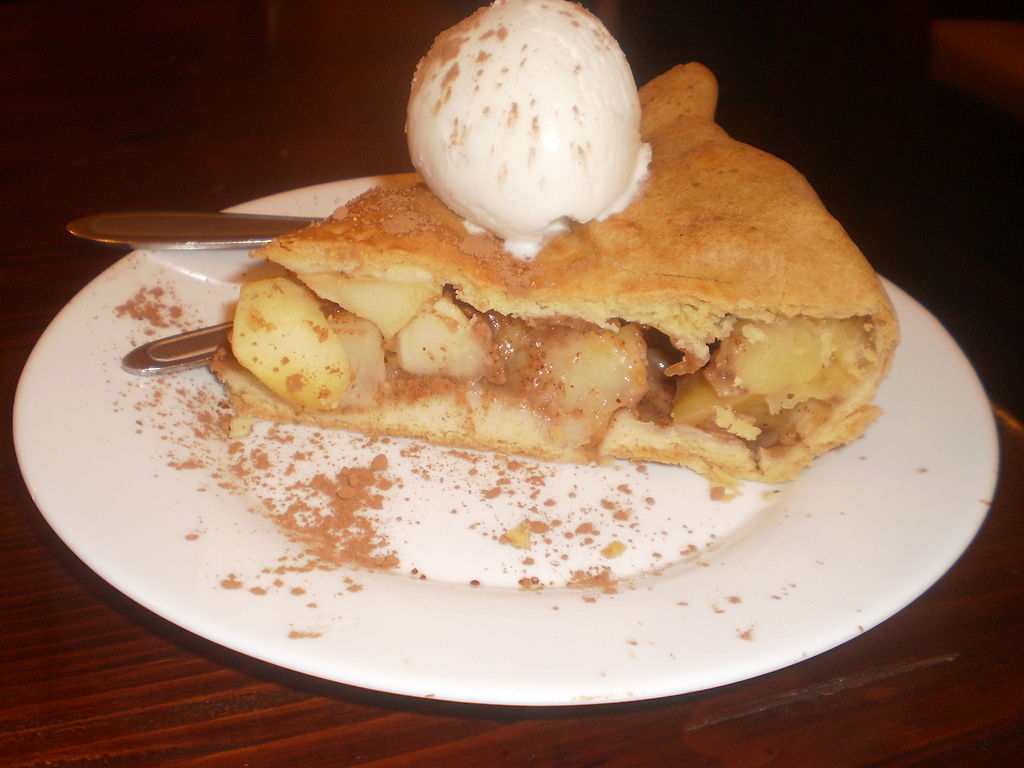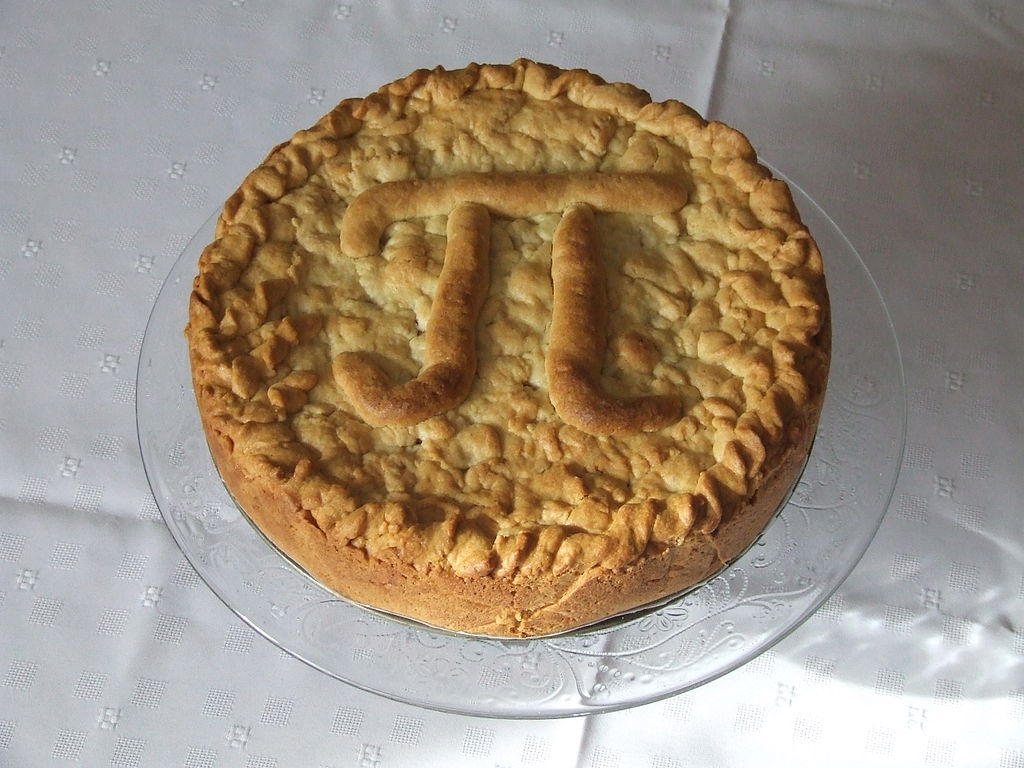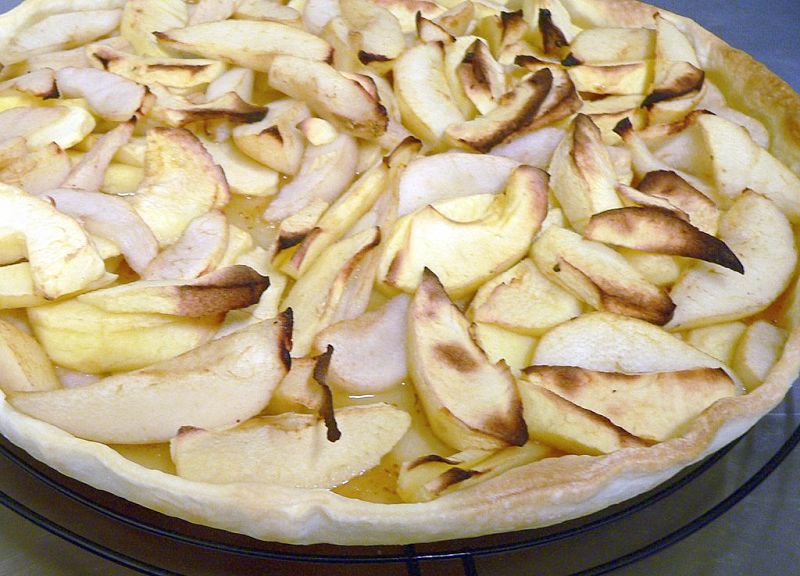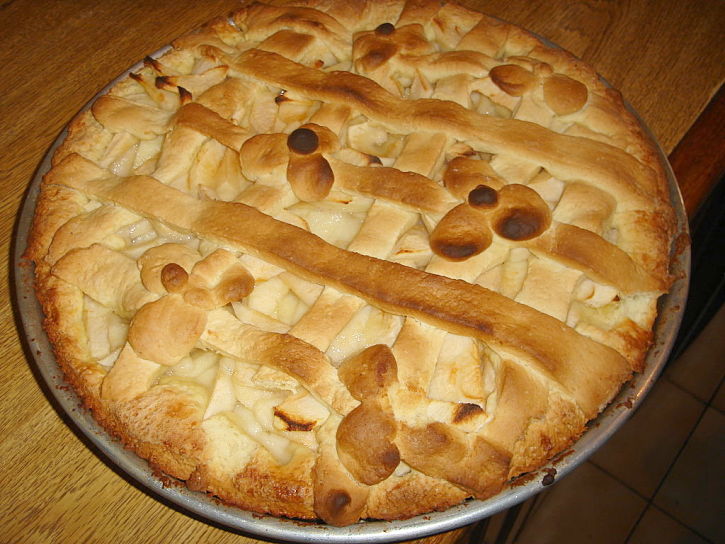Best Ever Apple Pie Recipes in the World - Easy, Simple and Homemade
Apple pies come in two forms. A so-called double-crust fruit pie where pastry is used top and bottom and a tart which has a pastry lattice woven with pastry strips on top.
Apple pies can also be made in a deep-dish form with a top crust only, and open-face with bottom crust only.
Baking the perfect apple pie is BOTH an art and a science.
You need to understand the key tips required to avoid disaster pudding.
How often did the crust shatter when you bit it, or worse was soggy and under-cooked?
How often are the apples a mushy mess with no flavor or texture?
Disappointment and embarrassment abounds when you don't get it right.
Well this should not happen again, if you follow the tips provided in this article.
See the fabulous set of recipes for the best ever, home-baked apple pie.
General Tips for making the Perfect Apple Pie
Keep everything cold - For the flakiest, most tender crust that melts in your mouth, it is vital essential that you keep all of your ingredients and equipment cold as you work. Flakey layers in the pastry develop when chunks of butter are squeezed and flattened in between layers of gluten formed in the flours. These alternating layers of butter and flour won't develop if the butter melts. And butter melts at room temperature, an so it must be chilled. So keep the butter in the refrigerator until you are ready to use it. Make sure the water you use is ice cold. Chill the flour before you start making the pie crust.
Mix your pastry gently - Kneading and over-working the dough when mixing or rolling, will make the crust tough.
Refrigerate the dough before rolling - This is another essential step that when missed ruins a good crust. Chill the dough in the refrigerator for 45 - 60 minutes to firm up the butter or other shortening and also helps to keep the pastry together as you roll it. Otherwise it may crack or crumble. Wax paper is an ideal substance to roll on. Once rolled you can simply invert the pastry over the pie pan, line it up, press into the pan and finally peel off the paper.
Use a deep-dish pie pan - Shallow pans make the pie less appealing because there is too little filling. Choose a pan that is at least 1 1/2 inches (4 cm) deep. A standard 9-inch round and deep pie pan has the capacity to hold 7 to 8 cups of sliced apples.
Choose the Best Pie Apples
Choosing apples that are tart, full of flavor when cooked and which retain their texture when cooked is the key to a fabulous filling. The best type of apple from best to worst is listed below. See the table at the end of the article for the criteria used to rank the apple types and their suitability for making apple pies.
- Braeburn
- Golden Delicious
- Gala
- Granny Smith
- Cortland
- McIntosh
- Rome
- Empire
- Fuji
- Red Delicious
Par-Cook the Apples - Strangely, par-cooking the apples means they hold their shape better when you bake them.They can be heated in a microwave, heated in a pan on the stove or immersed in boiling water and letting them stand for about 10 minutes. The last method is mots reliable and repeatable. Simply boil 1.5 pints of water to each pound of apples. (1.7 litres to each kilograms of apples). The amount is important because it determines the final temperature when the apples are added. Pour this boiling water over the apples (at room temperature) in a bowl. Cover and leave for 10 minutes before draining the apple slices. This will have softened the slices slightly, but left them firm and having their original shape. An extra bonus is that the apples will sit flatter when added to the pie crust avoiding the pockets of air that cab form with raw apples.
Enhance the Flavor, Don’t add more Sugar - Don't add extra sugar to the filling to boost the flavor, add 1 tablespoon lemon juice, 2 tablespoons melted apple jelly and some finely grated zest of an orange or a lemon.
Bake the pie in the middle of your oven on the center rack - If you pit the pan too high the pie crust may scorch. Lower lower the oven temperature the second half of the cooking time.
Control how the crust and filling cook - When you see signs that the pie crust is getting brown to quickly, put a large sheet of foil on top of the pie, leaving the sides loose.The foil reflects heat, but the base and the sides of the pan are unaffected.
Test for doneness of the filling, not just the crust - The cooking is done when the juices in the filling start to bubble prominently and you start to see juices at the edge of the pan. The crust should be golden brown. Undercooking the pie may mean the crust may be doughy and soggy.
Let the pie rest and cool to room temperature before serving - While hot apple pie straight out of the oven is very tempting especially with the aroma from the cooking wafting through the kitchen, the flavor will be less intense and it will be too ht to really taste and enjoy it. Letting the pie rest and cool to room temperature intensifies the flavor and will be more enjoyable. The crust will perform better as well, being flakier, and having a crisper texture.
Don’t kill the apple taste with too much seasoning - Too many apple pies are ruined by too much cinnamon and nutmeg. It's and apple pie - you should be able to taste the rich, tangy apple flavor.
Only Use Butter - Many traditional pie crust recipes include butter and shortening on the recipe lists. Using shortening and lard is easier because butter melts do easily.But lard and shortening simply lack the rich flavor of butter. The pros and cons of the various alternative are shown below:
Butter
- Pros: Excellent flavor, can promote distinct and large flaky layers when pastry is cooked.
- Cons: Hard to work with when cold and it becomes liquid at quite low temperature (below body temperature). This means it has a narrow and critical working range and has a very narrow workable range. Butter also has a higher water content (about 15-17% percent) than other shortenings. Requires special handling.
Shortening
- Pros: Much easier to work with than butter and produces pie crusts that are somewhat flakey and tender.
- Cons: It has no flavor at all other the fat taste. It also has a low melting point and is soft over the usual range of temperatures when making a pie. If it melts during the preparation the crust becomes crumbly rather than flaky.
Lard
- Pros: The best type of fat to work with as it remains solid. It makes tender, flaky crusts that are not crumbly.
- Cons: Hard to find a good lard that does not have a piggy-taste that taints the crust
Weigh the Flour - Weighing dry ingredients by volume is simply not accurate enough and can cause problems with the mixture being too wet or dry. Volume depends on packing in the measuring cup. This is avoided with weighing.
Use a food processor to cut the butter into the flour - It is very hard to accurately cut butter into the flour accurately by hand. It takes a lot of practice and getting the butter at the right temperature an cut into the right size pieces. It is much more efficient and consistent using a food processor fat into flour. Try to refine the technique by using short pulses to cut the mixture until has a crumb like mixture.
Traditional Apple Pie Recipe
For the pastry:
- 225 g (8 oz) butter chilled
- 2 eggs
- 350 g (12 oz) plain flour
- 50 g (2 oz) golden caster sugar , plus extra
- softly whipped cream for dressing
For the filling:
- 1kg (2 lb) Braeburn or Bramley apples
- 1/2 teaspoon cinnamon
- 140 g (5 oz) golden caster sugar
- 3 tablespoons of flour
Quarter, peel, core and slice the apples about 5mm (1/4 inch) thick. Pre-cook using hot water as described above or in the microwave. Simply place the apples in a bowl and heat in the microwave for about 3 minutes, stirring at one minute intervals. You may need to adjust the time based on your microwave.
For the pastry: Combine the butter, cut into small cubes and sugar in a large bowl until just mixed. Add one whole egg and the yolk of another. Beat for about 60 seconds to get a consistency of scrabbled eggs. Work in the flour, a third at a time, with a wooden spoon or spatula until it starts to form a ball. Use your hands to gently work the dough into a ball. Wrap the ball of dough in cling film, and chill for 45- 90 minutes.
For the filling: combine the cinnamon, flour and 140g (5oz) sugar, in a bowl large enough to hold the apples when added later.
Heat the oven to 190 degrees C (375 degrees F). Lightly beat one egg white with a fork and use this as a glaze for the top of the pie. Take two- thirds of the pastry and roll out on waxed paper to the size required for the 9 inch (20 cm) round pan (4 cm deep: 2 inches deep). Line the pan with the pastry leaving a slight overhang. Roll the remaining third of the pastry into a circle for the top.
Dry the apple slices using kitchen paper, and dip them into the bowl with the sugar and cinnamon mixture. Then add the apples to the pan lined with pastry.
Brush some water on the rim of the pastry in the tin and place the pastry lid on top. Press the edges together to seal the top and bottom together. Trim the edge using a sharp knife. Make 4-6 small slashes through the top layer to permit steam to escape.
Brush the top of the pie with egg white and sprinkle with a little caster sugar. Bake for 40-50 minutes, until the crust is golden and the apple has started to bubble. When cooked remove from the oven and let it sit for about 5 to 10 minutes. Cool and serve with whipped cream.
Classic Apple Pie with Homemade Pastry
For the Pastry:
- 3 tablespoons (45 ml) sour cream
- 1/4 cup Ice water
- 1 cup cold butter, cubed
- 1/2 teaspoon salt
- 2-1/2 cups (625 ml) all-purpose flour
In large bowl, mix the salt into the flour with salt. Using pastry blender, cut the butter cubes into the flour until it has the texture of fine crumbs dotted with larger pieces. Whisk the water with the sour cream. Drizzle into the flour mixture, mixing with a spatula. Add a small amount of water to create a ragged dough ball. Divide into halves, squash into two thick discs. Wrap in cling wrap and refrigerate for 30-45 minutes
For the Filling:
- 2 tablespoons of butter, softened
- 1 pinch salt
- 1 pinch ground nutmeg
- 1 teaspoon cinnamon
- 2 tablespoons of cornstarch
- 3/4 cup granulated sugar
- 8 apples - about 3 lb (1.5 kg)
Peel and core apples and then cut into 1/4-inch (5 mm) thick slices. Pre-cook the apples and then dry and place in a large bowl. Mix the sugar, cinnamon, cornstarch, salt and nutmeg together and toss in the apples and mix to coat.
Using a floured board, roll half of the pastry out to about 1/8-inch (3 mm) thick. Place into a 9-inch (20 cm) buttered pie plate. Remove excess but leave a 3/4-inch (2 cm) overhang. Fold the edge under and flute the edges. Add the filling into pie shell, and dot with pieces of butter. Roll out the other half of the pastry. Whisk one egg yolk together with 1 tablespoon of water. Brush the pastry rim with the egg mixture to act as a seal between the top and bottom. Fit the pastry lid on top of the filling and trim, but leaving 3/4-inch (2 cm) overhang. Fold the top overhang under the bottom rim of the pastry. Seal and flute the edges together.
Brush egg mixture over the top of the pie. Cut several steam vents into the top, and sprinkle over coarse sugar. Bake in the bottom third of your oven that has been pre-heated to 450 degrees F (230 degrees C) oven for 10 minutes. Then, lower the heat to 350 degrees F (180 degrees C); bake for another 65 minutes.
Test for doneness to ensure the pie bottom is golden brown and filling is bubbling. Let the pie cool on a rack before serving warm.
Suitability of Various Type of Apples for Pie Fillings
|
Type of Apple
|
Pie Sutability Rating (1-10)
|
Flavor
|
Texture
|
Comment
|
|---|---|---|---|---|
|
Braeburn
|
7
|
Very sweet and mildly tart with a unique citrusy aroma, similar to Granny Smith almost pear-like flavor when cooked. Low in acidity, but a crisp and juciy apple with a unquie
|
Braeburns are relatively dense apples that retain their shape very well, even as they completely soften
|
Braeburns soften fully when cooked but still retain good texture due to the high density of the flesh. Excellent golden color. Braeburns have an excellent combination of tartness, flavour and texture retention when cooked
|
|
Golden Delicious
|
6
|
Sweet, tart, crisp and a somewhat buttery taste, but needs to be very fresh. Well balanced and rich flavor, that is enhanced by cooking.
|
Crisp when fresh, but becomes stale and soggy when older and can develop a flowery and mealy taste. When baked, it the flesh softens but retains some texture
|
Fantastic flavour when fresh. Could be firmer when cooked but still an excellent pie apple
|
|
Gala
|
6
|
Mildly tart and sweet. Resists bruising
|
Very thin-skinned with a firm grainy texture
|
When baked, they retain their texture and shape, but the graininess can overwhelm their mild taste. Smooth-textured apples are preferred
|
|
Granny Smith
|
5
|
Very clear, sparkling and tart when fresh. They have a distinct acid and citrus aroma that resembles white wine.
|
Very firm texture and crunchy. Becomes slightly grainy and less crisp when not fresh.
|
Good texture retention when cooked and good appearance. However flavour is partially lost when cooked
|
|
Cortland
|
4
|
Similar to McIntosh apples, but more tart and sweeter. Has delicate white flesh and a mild flavor
|
Tender and can be slightly grainy. Some texture retained when cooked
|
Good pie apple in terms of texture but flavor is rather insipid and not strong enough.
|
|
McIntosh
|
3
|
Sweet, yet mildly tart with very white flesh.
|
Tender and slightly grainy, especially when not fresh
|
Flesh turns brownish and mushy when cooked.
|
|
Rome
|
3
|
Very mild taste, and not so sweet, when fresh, but develops more flavor when cooked.
|
They have firm flesh and a thick skin.
|
They can go brown and somewhat mushy when baked.
|
|
Empire
|
3
|
Very sweet, juicy and very tart.
|
Texture is firm and crunchy.
|
When baked, they have nice texture, but become over-sweet, when cooked. This kills the acidity and tart flavour which is too mild for the sweetness.
|
|
Fuji
|
2
|
Quite sweet and fresh tasting, but flavor is quite delicate and does not survive cooking
|
Crisp texture is a pear-like with rich moisture and mildly crunchy.
|
The mild flavor does not get a boost when cooked. Has a watery tart taste with some texture retained when cooked.
|
|
Red Delicious
|
1
|
Very sweet and one-dimensional taste.
|
Mealy flesh that turns to mush when cooked. Skin is thick and can often be bitter. Fine when very fresh but age very poorly.
|
Become very mushy when cooked, even minimally. Resemble sloppy applesauce
|
More Images
